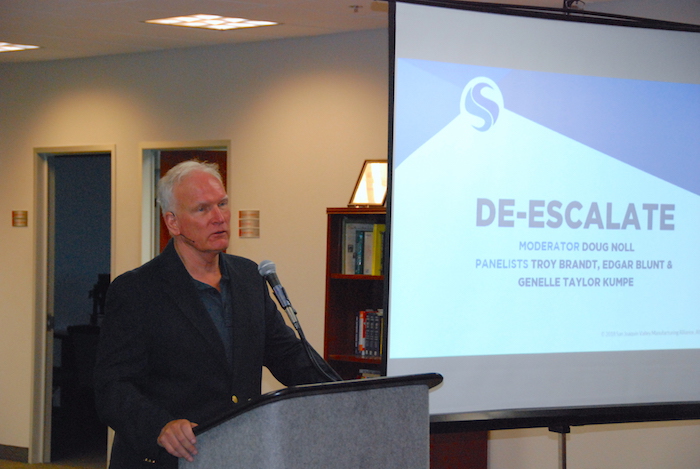
Former attorney turned self-described “peacemaker” Doug Noll, offers members of the San Joaquin Valley Manufacturers Alliance advice on how to de-escalate high emotions during workplace conflicts last week during the group’s third-quarter meeting. Photo by David Castellon
Written by
When dealing with moments of conflict or acts of outright aggression in the workplace, Doug Noll suggests the key to de-escalating such situations is listening.
But don’t ask go straight into problem-solving mode – as many are inclined to do – if the emotions of the people involved are high, said the former attorney turned professional mediator and author.
Instead, he advised members of the San Joaquin Valley Manufacturers Alliance gathered last week for their third-quarter meeting in Fresno to listen to the emotions their employees express and use affect labeling – identifying those emotions and stating them back to the person – as a way to de-escalate a situation before trying to get deeper.
The mediator said his method centers around listening intently and letting the other person know that you understand “exactly what they say, what they mean and what they’re feeling. When you do that as a listener, everything calms down.”
Noll, who lives near Prather, has considerable expertise on the subject, having spent 22 years as a lawyer before changing careers to mediation and conflict resolution.
He told the audience gathered at the Betts Co. headquarters in Fresno he has personally worked with more than 1,500 prison inmates – training many to be mediators among their prison populations and successfully reducing violence rates – as well training other mediators and staff at the U.S. Congressional Budget Office to de-escalate conflicts with members of Congress and their staffs.
And then there’s his latest book, published last year, “De-Escalate: How to Calm an Angry Person in 90 Seconds or Less.”
While his suggested methods of de-escalation may seem simple at first blush, they actually may require an intellectual shift, Noll told the crowd.
“And this is the shift I think that every one of us has to make if we want to move out of the kind of chaos we live in to a place of greater peace and inner harmony. An intellectual shift is very simple: We are 98 percent emotional and 2 percent rational.”
“We are not rational beings – no way, no how. And the moment that we can make the shift to get away from rationality as the primary differentiation of humans from other animals, the quicker we can move into a place where we can really relate to each other as true human beings.”
Acknowledging the emotions of others during moments of conflict is important in the workplace to ensure those conflicts don’t worsen, he said.
“Basically, what happens is that when we become highly emotional, our pre-frontal cortex shuts down, our emotional centers light up, we lose the ability to do anything other than be reactive to our emotions,” Noll explained.
“And unless we are highly skilled, that reactivity leads to a condition called ‘alexithymia’ – the inability to understand, name or manage our own emotions,” which, he said, is when people “lose it.”
To avoid this, Noll suggested employers, human resources staff, managers, mediators and others who have to deal with workplace conflicts use affect labeling, which essentially is identifying the emotions of the other person – anger, frustration, worry, etc. – and simply stating them to the person experiencing them, such as saying, “You are scared.
“Ignore the words and get to the emotions. Reflect back the emotions with a simple ‘you’ statement,” he added.
“What affect labeling does is that we as the listener lend our pre-frontal cortex to the speaker for about 30 seconds – that’s all it takes, 30 seconds – and as we process the emotional experience we are guessing at, that we think that the speaker is having, that allows the speaker’s frontal cortex to come back online. The emotional centers quiet down, and the problem is solved.”
If you guess the wrong emotion, that’s OK, as the speaker generally will correct you, which also can have a calming effect, Noll said.
He also advised it’s important is to keep the discussion going about the person experiencing the emotions, so listen intently – don’t check your watch or be distracted by other things – and avoid “I” statements, which include, “Oh, that happened to me,” or “What I hear you saying …”
“So, when you really learn how to listen, it’s a very different skill from conversation. And you make a committed conscious choice to listen in that moment,” Noll explained.
“You know you are because you are in the speaker’s frame of reference. The moment you use the ‘I’ word, you aren’t listening. The moment you ask a question, you are no longer listening,” he said.
“I would say what [the other person] just said was and paraphrase the core message, or ‘What you’re feeling is, you are angry, you’re frustrated.’ If you do that, you’re on the speaker’s track, and that’s where I want to be all the time.”
Once emotions are de-escalated, then a discussion on the causes of the problems and how to fix things should occur, but even then the speaker should be invited to discuss his or her feelings on these matters, Nell told the audience.
“Listen first, calm people down and then go into problem solving. Then you ask how to go about solving a problem, how to prevent it again and invite input on the consequences.”
And that may not be necessary, said Nell, adding that “In conflict, I find that about 80 percent of the time if you de-escalate, that’s the end of he problem.”








